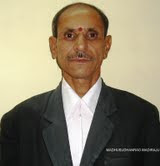THE HON'BLE MR JUSTICE RAMESH RANGANATHAN
Contempt Case No. 1370 OF 2005
21-09-2007
N. Venkata Swamy Naidu
M/s. Sri Surya Teja Constructions Pvt. Ltd, Gandhinagar, Sy. No. 151, Rayala Avenue Apartments,
Hyderabad and others.
Counsel for the petitioner: Sri K. Vasudeva Reddy.
Counsel for the Respondents 5 & 7: Sri K. Satyanarayana Murthy Counsel for the Respondent No. 6: Sri
Dantu Srinivas.
Counsel for the Respondent No. 8: Sri B. Chandrasen Reddy.
:ORDER:
Seeking to have respondents 1, 2, 4 to 9, punished under the Contempt of Courts Act, for wilful disobedience
and gross violation of the orders of the Company Law Board, Additional Principal Bench, Chennai dated
18.07.2005, this contempt case is filed.
Facts, to the extent relevant, are that C.P. No. 24 of 2004 was filed by the petitioner herein, before the
Company Law Board, under Sections 397, 398 and 402 read with Section 111 of the Companies Act, 1956.
Among the interim reliefs sought for included an order to prevent the sale or dispossession of the land of the
company and to prevent injury being caused to persons who were allotted flats in the project. Petitioner would
submit that, when the Company Petition was pending consideration before the Company Law Board,
respondents 1, 2, 4 to 9 had demolished the superstructure of the building necessitating his filing an
application, in C.A. No. 84 of 2005, requesting the Company Law Board to interfere and grant status quo with
regards the existing structure. The Company Law Board, by order dated 18.07.2005, granted status quo.
According to the petitioner, the respondents continued to demolish the building, in violation of the order of
"status quo", and when he brought these violations to its notice, the Company Law Board, by order in
C.A.No.87 of 2005 dated 22.07.2005, appointed an Advocate Commissioner to verify and submit a report on
the status of the superstructure and the physical features of the disputed property. The Advocate
Commissioner, in his report dated 31.07.2005, informed that he had visited/inspected the disputed site on
24.07.2005 and was assisted by the Counsel for the petitioner Mr. Dhanaraj and Mr. Rajnish Garje, the
Company Secretary representing the respondents, that at the disputed site a group of twenty persons had met
him and had represented that, though they had spent large sums of money for buying flats/houses, they were
cheated, that the flats/houses were never constructed/delivered, that Sri K. Umamaheswara Rao, who was
present at the site, was introduced to him by Mr. Rajnish Garje as one of the respondents, that Mr. Reddy,
who was also present along with the respondent, had introduced himself as the builder, that he had issued
memos to both the representatives of the petitioner and the respondents and had obtained attendance memos
from them, that he had shot several photographs of the disputed site/structure, that the site consisted of two
structures, one finished and the other partially demolished, that at the entrance of the site there were remains
of a completely damaged structure, that demolition was in progress and it appeared that almost 70% of
demolition had just been completed, that even the debris was not removed from the site, that steel rods were
still found lying, that the structure, located at the entrance of the disputed site adjoining the main road, had
already been demolished, that only some pillars were visible and it appeared as if the entire debris had just
been shifted, that he found tyre/wheel marks of some heavy vehicles on the ground, that he had taken
photographs of persons present at the site including Mr. Reddy and Mr. Umamaheswara Rao, that his overall
N. Venkata Swamy Naidu vs M/S. Sri Surya Teja Constructions ... on 21 September, 2007
Indian Kanoon - http://indiankanoon.org/doc/400488/ 1
